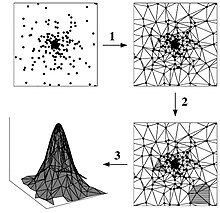Delaunay tessellation field estimator: Difference between revisions
No edit summary |
No edit summary |
||
| Line 45: | Line 45: | ||
The resulting two- and three-dimensional maps reveal |
The resulting two- and three-dimensional maps reveal |
||
an impressive view on the cosmic structures in the nearby universe. |
an impressive view on the cosmic structures in the nearby universe. |
||
<gallery caption="" widths="350px" heights="200px" perrow="6"> |
|||
[[Image:2dfgrs.png|right|thumb|300px|Rendering of the 2dFGRS data]] |
|||
Image:2dfgrs.png|[[w:Rendering of the 2dFGRS data|Rendering of the 2dFGRS data]] |
|||
Image:2dfdtfe.gif|[[w:DTFE reconstruction of the 2dFGRS data (inner parts)|DTFE reconstruction of the 2dFGRS data (nearby parts)]] |
|||
</gallery> |
|||
=== Numerical simulations of structure formation === |
=== Numerical simulations of structure formation === |
||
Revision as of 16:22, 28 October 2007
The Delaunay Tessellation Field Estimator (DTFE) is a mathematical tool for reconstructing a volume-covering and continuous density or intensity field from a discrete point set. The DTFE has various astrophysical applications, such as the analysis of numerical simulations of cosmic structure formation, the mapping of the large scale structure in the universe and improving computer simulation programs of cosmic structure formation. It has been developed by Willem Schaap and Rien van de Weijgaert.
Method
The DTFE consists of three main steps:

Step 1
The starting point is a given discrete point distribution. In the upper left-hand frame of the figure a point distribution is plotted in which at the center of the frame an object is located whose density diminishes radially outwards. In the first step of the DTFE the Delaunay tessellation of the point distribution is constructed. This is a volume-covering division of space into triangles (tetrahedra in three dimensions), whose vertices are formed by the point distribution (see figure, upper right-hand frame). The Delaunay tessellation is defined such that inside the interior of the circumcircle of each Delaunay triangle no other points from the defining point distribution are present.
Step 2
The Delaunay tessellation forms the heart of the DTFE. In the figure it is clearly visible that the tessellation automatically adapts to the both the local density and geometry of the point distribution: where the density is high, the triangles are small and vice versa. The size of the triangles is therefore a measure of the local density of the point distribution. This property of the Delaunay tessellation is exploited in step 2 of the DTFE, in which the local density is estimated at the locations of the sampling points. For this purpose the density is defined at the location of each sampling point as the inverse of the area of its surrounding Delaunay triangles (times a normalization constant, see figure, lower right-hand frame).
Step 3
In step 3 these density estimates are interpolated to any other point, by assuming that inside each Delaunay triangle the density field varies linearly (see figure, lower left-hand frame).
Applications
An atlas of the nearby universe
One of the main applications of the DTFE is the reconstruction of the cosmic density field in the nearby universe. In Chapter~7 we have reconstructed the density field corresponding to the 2dF Galaxy Redshift Survey. The resulting two- and three-dimensional maps reveal an impressive view on the cosmic structures in the nearby universe.
Numerical simulations of structure formation
Most algorithms for simulating cosmic structure formation are particle hydrodynamics codes. At the core of these codes is the smoothed particle hydrodynamics (SPH) density estimation procedure. Replacing it by the DTFE density estimate will yield a major improvement for simulations incorporating feedback processes, which play a major role in galaxy and star formation.
The cosmic velocity field
The DTFE has been designed for reconstructing density or intensity fields from a discrete set of irregularly distributed points sampling this field. However, it can also be used to reconstruct other continuous fields which have been sampled at the locations of these points. The use of the DTFE for this purpose has the same advantages as it has for reconstructing density fields. The fields are reconstructed locally without the application of an artificial or user-dependent smoothing procedure, resulting in an optimal resolution and the suppression of shot-noise effects. The estimated quantities are volume-covering and allow for a direct comparison with theoretical predictions. In this chapter we have focused on the simultaneous reconstruction of the density and velocity fields corresponding to cosmological $N$-body simulations. The resulting fields closely adhere to the continuity equation. The DTFE reconstruction results in realistic density and velocity profiles without having to resolve to artificial smoothing procedures. The results show that the DTFE represents a major step forward for the analysis of cosmic velocity fields at both small and large scales.
Evolution and dynamics of the cosmic web
The DTFE has been specifically designed for describing the complex properties of the cosmic web. In Chapter~6 we have analyzed a number of simulations of cosmic structure formation. By means of a simultaneous DTFE reconstruction of the cosmic density and velocity field we have analyzed the dynamics of characteristic elements of the large scale galaxy distribution. We have described a number of analytic models of voids and shown that the DTFE reconstructions closely adhere to these models. We have also discussed how voids can be used to constrain the value of the cosmological constant. Finally, we have shown that the DTFE reconstructed density and velocity field near superclusters reproduces the theoretically expected infall patterns.
External links
- DTFE: the Delaunay Tessellation Field Estimator, Willem Schaap, 2007, PhD Thesis, Rijksuniversiteit Groningen, The Netherlands
This article has not been added to any content categories. Please help out by adding categories to it so that it can be listed with similar articles. (October 2007) |


